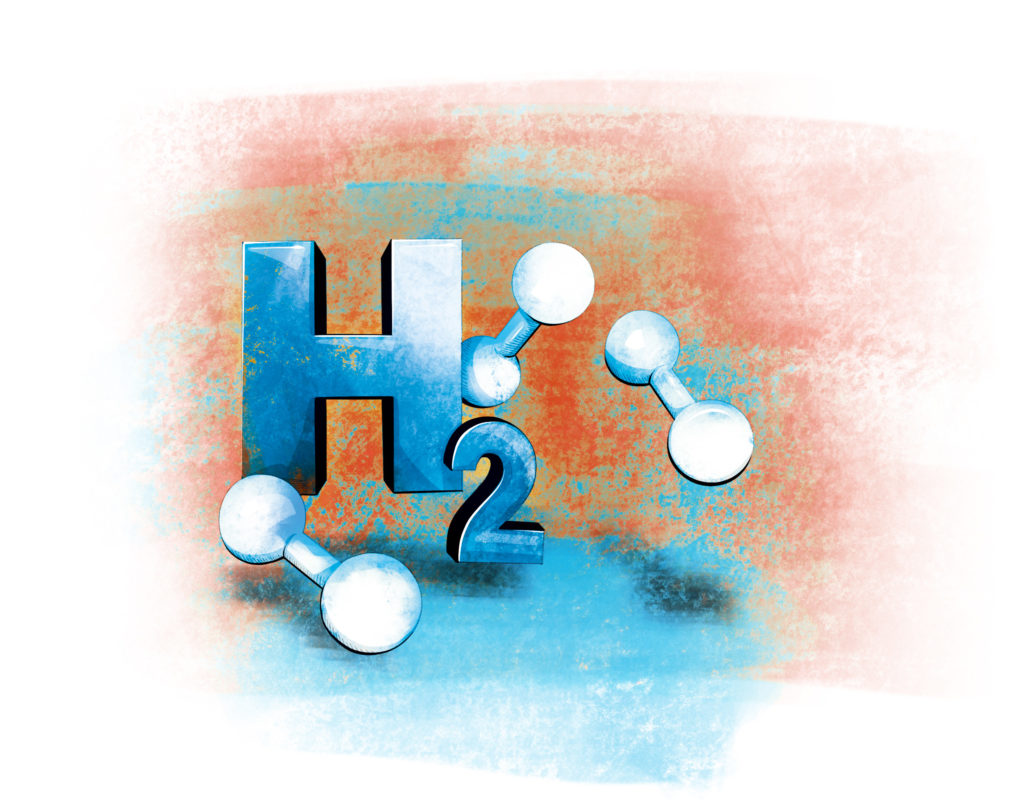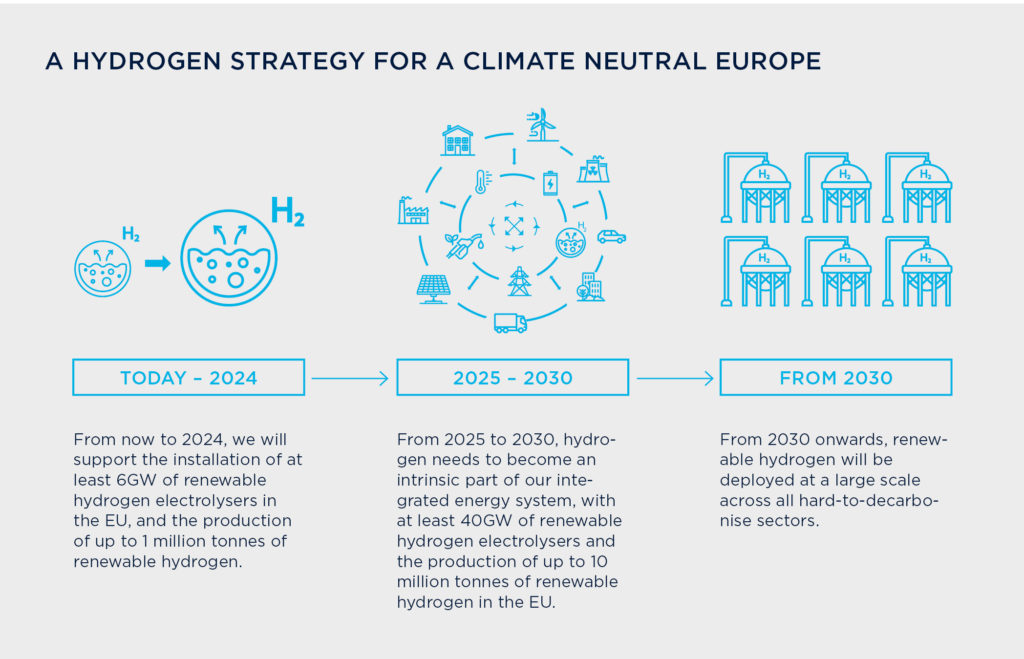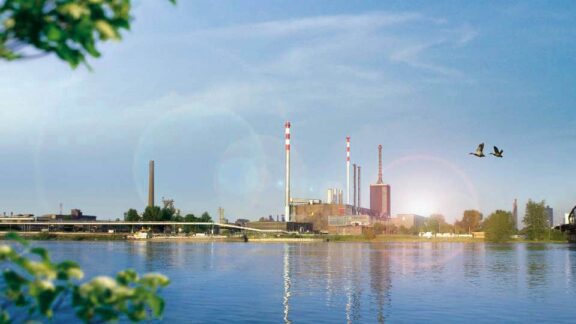What will tomorrow’s world look like—a world that has implemented
the innovations pioneered today? A world based on the groundbreaking technological, social, and political ideas that have only just surfaced? In this series, Metals Magazine’s independent editor James Gray takes a peek into his crystal ball and lets us know what the future of hydrogen holds for the steel industry.
Frequently touted as the “fuel” of the future, I find it fascinating just how many false starts hydrogen has had over the years, dating back to the airships of the early 20th Century and the oft-cited Hindenburg disaster of 1937, which dashed any hopes in hydrogen in a mere 32 seconds, and even beyond that to 200 years ago, when hydrogen powered the first combustion engines. But experts agree that with industries clamoring to move away from fossil fuels in favor of cleaner and more sustainable sources of energy, and the EU striving to become carbon-neutral by 2050, hydrogen’s time may finally have come.
Let’s get something clear first, though. Although it can be used as a fuel, hydrogen is not an energy source, it is actually a form of energy storage—an energy carrier, similar to electricity, and capable of delivering huge amounts of energy. The production of hydrogen requires another energy source such as natural gas, or renewable electricity if we want to generate “clean” hydrogen. The hydrogen produced is then turned back into energy, which, as I will discuss in this article, can be used almost ubiquitously. The confusion surrounding what exactly hydrogen is has, perhaps, been one of the main reasons why it has struggled to gain traction.
Hydrogen (H) is the simplest and most abundant element on earth, comprising one proton and one electron, and exists naturally as a molecule. However, because hydrogen as a gas barely exists naturally—it is lighter than air and so rises into the atmosphere—, it has to be manufactured from compounds that contain it, such as water, natural gas, or coal, and then stored. Hydrogen has the highest energy content of any fuel by weight, yet the lowest energy content by volume. Hydrogen, like electricity, is an energy carrier; energy carriers are used to move, store, and deliver energy in a usable form.

WHY THE HYPE—AND WHAT’S THE CATCH
Hydrogen can be made safely from a variety of fuels including renewables, nuclear, natural gas, coal, and oil. Hydrogen itself is a high-efficiency, low-polluting fuel, a clean energy carrier that produces only water, electricity, and heat when consumed in a fuel cell. Widely versatile, it can be transported as a gas via pipeline—often cheaper than sending electricity over long distances by wire—or in liquid form, and large volumes can be stored easily, for example underground, in tanks as compressed hydrogen, or through chemical compounds that release hydrogen after heating.
At the moment, however, hydrogen use is dominated by industry, primarily oil refining, in agriculture to create fertilizers, and steel production. The lion’s share of this hydrogen is supplied using fossil fuels, and that’s one of the biggest problems. Policymakers agree that clean hydrogen holds huge potential in terms of reducing greenhouse gas emissions. In the U.S.A., only a small fraction of the hydrogen produced is used as an energy carrier, but as leaders all over the world seek to reduce dependence on fossil fuels, hydrogen now represents an attractive and sustainable alternative.
In Europe, hydrogen as a clean fuel can play two key roles as the EU strives to achieve its climate neutrality goals: firstly, enabling greater use of renewable electricity, and secondly decarbonizing CO2-intensive sectors, such as chemicals, cement, and steel production. The global steel industry actually produces more CO2 than steel, with about 1.8 tons of CO2 released into the atmosphere for every ton of liquid steel, which equates to around 7-10 percent of global CO2 emissions.
Hydrogen is today enjoying unprecedented momentum. The world should not miss this unique chance to make hydrogen an important part of our clean and secure energy future.”
Dr. Fatih Birol
Executive Director of the International Energy Agency
THE SPANNER IN THE WORKS
With hydrogen hailed as the solution to our energy problems, why has progress been so slow? Here we have a high-efficiency, versatile energy carrier with the potential to provide clean, safe, and affordable energy, and after all, hydrogen is the most abundant element in the universe, right? The problem lies in a fact we touched upon earlier, that hydrogen does not naturally exist on Earth in its elemental form and so has to be produced from compounds that contain hydrogen in processes that require a lot of energy in the first place.
Almost all hydrogen for industrial use is currently produced using fossil fuels, and—as Tesla CEO Elon Musk has pointed out, dismissing fuel cells as “fool cells”—, it takes a huge amount of energy to turn hydrogen into useable fuel. Hydrogen production can be split into three main categories: thermal, electrolytic (the most common method), and photolytic processes. Thermal processes rely on the energy in natural gas, coal, or biomass in order to produce hydrogen, and include natural gas reforming, gasification, renewable liquid fuel reforming, and high temperature water splitting. Electrolytic processes split water into hydrogen and oxygen using electricity, while photolytic processes do the same using light energy.
Another issue is that in order to efficiently and cost-effectively move hydrogen from its point of production and deliver it to points of end use, such as vehicle refueling stations, an appropriate infrastructure (pipelines, trucks, rail routes, etc.) first has to be put in place.
GAINING MOMENTUM
Hydrogen is a versatile energy carrier that already has multiple applications and, according to a report by the International Energy Agency (IEA), it is building “unprecedented momentum”. The fuel cell, which is an energy-conversion device designed to convert and use the power of hydrogen, ideally in a highly efficient way, is crucial. Hydrogen can be used to power vehicles, as well as homes and offices, and even portable electronic equipment such as laptops or generators. Stationary hydrogen fuel cells can be used to power critical facilities such as hospitals and data centers, and to provide backup power for regional emergency shelters, telecommunications in remote locations, remote weather stations, or to supply power to rural locations that are not connected to the electric power grid.
POWER TO THE PEOPLE
Hydrogen-powered cars have perhaps stolen the limelight, but beyond powering all types of vehicles, there are other exciting ways that hydrogen fuel cells are already being used. Stationary applications that produce electricity and heating are one such innovation. In stationary fuel cell configurations, the fuel cells are either connected directly to the power grid or installed as grid-independent generators of electricity or heating.
Asia is at the forefront of this green technology with a number of groundbreaking initiatives. The Gyeonggi Green Energy fuel cell park in Hwasung City, South Korea, is the largest fuel cell park in the world. It consists of 21 fuel cells and boasts a total output of 59 megawatts of electricity, delivering ultra-clean, renewable power to the grid and usable heat to a district heating system. The world’s first hydrogen fuel cell power plant, located in Daesan, South Chungcheong Province, is designed to deliver by-product hydrogen via underground pipelines. It generates 400,000 megawatt-hours of electricity to power 160,000 households every year.
South Korea has its sights set on creating the first hydrogen-powered society and has announced ambitious plans to build three hydrogen-powered cities by 2022. The cities will use hydrogen as the fuel for cooling, heating, electricity, and transportation systems. The plan is part of a broader strategy to power 10 percent of South Korea’s cities, counties, and towns with hydrogen by 2030, with a further push to 30 percent by 2040.


ALL ABOARD
I would stick my neck out and say that transportation is one of the more exciting areas for the application of hydrogen technologies, and Europe already has a head start. The world’s first hydrogen-powered train has been operating commercially in Lower Saxony, Germany, since 2018 already. The Coradia iLint is a zero-emission regional passenger train that emits only steam and condensed water. The iLint boasts clean energy conversion, flexible energy storage in batteries, and smart management of traction power, and is designed for non-electrified lines. The high-performance train has also been carrying passengers for the Austrian Federal Railways, for a three-month stint that ended in November 2020.
FLIGHT OF FANCY?
So what does the future hold? As I mentioned, I believe that transportation is the big one, but that covers a wide area, from passenger vehicles to commercial trucks, buses, trains, and shipping. I am prepared to speculate that the real potential for hydrogen—in the transportation sector, at least—lies in aviation. The advantage hydrogen has over let’s say battery technology is its unbeatable energy-to-weight ratio, owing to its exceptionally low density. It is for this reason that hydrogen is favored by NASA for its space programs.
The aviation industry, having once ditched hydrogen in favor of biofuels from sustainable sources, and because of the massive energy costs involved in making hydrogen, is now revisiting the technology. Back in 2000, aerospace giant Airbus was involved in the 26-month, EC-funded Cryoplane project to evaluate liquid hydrogen as a means of powering the zero-carbon-emissions aircraft of the future. The upshot was that aircraft would require fuel tanks four times larger than traditional tanks, and the resulting larger exterior surface areas would increase energy consumption at least tenfold.
Now Airbus has revealed plans for the potentially first commercial zero-emission aircraft and is bullish that its hydrogen-fueled passenger planes could be in service by 2035. Airbus has produced three concept designs—codenamed ZEROe—that align with its stated ambition to decarbonize the entire aviation industry: a turbofan design capable of carrying up to 200 passengers more than 2,000 miles, a short-haul turboprop concept, and a “blended-wing body” design. All three would use gas-turbine engines burning liquid hydrogen, and hydrogen fuel cells would produce electrical power. The biggest stumbling block, says Airbus, is the massive investment required from airports in a refueling infrastructure.
Meanwhile in Bedfordshire, U.K., a small hydrogen-powered commercial aircraft from ZeroAvia has already taken to the skies: a six-seater Piper M-class plane powered by a hydrogen-electric engine. The company is aiming to make hydrogen planes commercially available within three years, and claims that the science for a long, zero-emissions flight by the end of this decade already exists. In this case, too, an overhaul of ground-operations infrastructure would be essential. ZeroAvia’s project has the backing of the U.K. government as part of the Jet Zero Council initiative, geared toward making net-zero emissions flights a reality.
While fuel cells are similar to batteries, producing electricity without combustion or emissions, they do not run down or need recharging, providing there is a continuous supply of fuel and oxygen. A single fuel cell comprises an electrolyte between two electrodes, an anode and a cathode, and its job is to directly convert the chemical energy in hydrogen into electricity and heat. Within the fuel cell, hydrogen electrochemically combines with oxygen to create electricity, and the only byproducts are pure water and useful heat, which is what makes this technology so attractive. Not only are fuel cells zero-pollution devices, they are also two to three times more efficient than conventional internal combustion technologies. The grid-independence of fuel cells also makes them ideal for powering facilities such as data centers, hospitals, and emergency response systems, where continual power is critical.

Visit meta.ls/euhydrogen for further reading.
I wanna be a rockstar
Frans Timmermans, First Vice-President of the European Commission and Executive Vice-President for the European Green Deal, speaking at the launch of the Hydrogen Strategy, eulogized hydrogen as “the rockstar for new energies all across the world”. The ambitious Hydrogen Strategy is geared toward decarbonizing the economy through the use of clean hydrogen produced using wind and solar energy in order to achieve climate neutrality by 2050. Although demand for hydrogen is undoubtedly on the increase, production is still responsible for CO2 emissions of around 830 million tons per year. Not only that, the cost of production itself needs to be brought down drastically. If hydrogen is to make a significant contribution to clean energy transitions, it needs to be adopted in sectors where it is virtually absent, like long-haul transport, chemicals, iron and steel, buildings, and power generation, where infrastructures are still woefully inadequate.
One thing is clear: the development of technologies geared toward producing hydrogen at lower cost, combined with building an infrastructure capable of both efficiently and cost-effectively storing and delivering hydrogen while also making it easy to use, will require a global effort across many industries and sectors. Only then will hydrogen become commercially viable. Governments, renewable electricity suppliers, car manufacturers, and oil and gas companies, are all throwing their considerable weight behind hydrogen technologies, while investments will inevitably boost economies around the world and create skilled jobs. All the signs are that the benefits clearly outweigh the costs—so as I gaze into my trusty crystal ball, I confidently predict that this time around, we are not on the brink of another false dawn. We will have lift-off.


